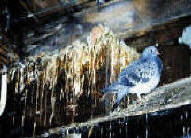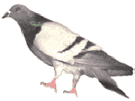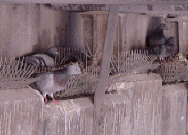![]()
![]()
![]()
| HOME |
| ABOUT US |
| SERVICES |
| BIRDS |
| BEES |
| PRODUCTS |
| PROJECTS |
| RESIDENTIAL |
| COMMERCIAL |
| OTHER PEST |
| FAQ |
| PMP's |
| LINKS |
| HELP WANTED |
| CONTACT US |
Southwestern States Commercial Service 1.877.828.2473
See a detailed list of Bird Disease -Click Here

Health Risk Associated with pest pigeons & birds
FACT: Pest bird can harbor over 40 types of parasites and host internally 60 types of infectious diseases that can be spread by the dried bird droppings to you, your family, employees and pets.

People who would never tolerate a colony of rats living in their attic or home will turn a blind eye towards pigeons or other birds entrenched in the overhangs or rafters of their roof. Yet, in terms of disease and damage, the two pests are quite similar. In order to better understand how nuisance birds (or rats with wings for that matter) spread disease we need to understand the basics of disease and transmission.
What
is a Disease?
When normal body functions become disrupted due to a foreign invaders or
an internal malfunction, we call the disruption a disease. Diseases caused
by foreign invaders are called infectious diseases. The invading agents
that account for the majority of infectious diseases are grouped in the
following five categories; viruses, bacteria, mycotic (fungal), protozoal
and rickettsial. From a layman's standpoint, the classification and definitions
of disease are less important than how these diseases spread and how can
we protect ourselves from them. Diseases need to be transported from place
to place in order to spread.
Birds are a perfect mechanism for
spreading disease because they travel great distances, harbor over forty
types of parasites and can host internally over sixty types of infectious
diseases that can effect you, your family and pets and now with the
possible treat
in the next few years of bird flu, controlling pest birds around your home
or business is even more
important.
of parasites and can host internally over sixty types of infectious
diseases that can effect you, your family and pets and now with the
possible treat
in the next few years of bird flu, controlling pest birds around your home
or business is even more
important.
Fortunately, human interaction with most bird species is minimal, thus drastically reducing any health threat from most birds. However a few bird species have successfully adapted to our urban environment. The pigeon, starling and house sparrow have learned to thrive living in our buildings and eating our food. Their adaptation to our communities has brought them into close proximity to humans. These three non-native birds have become a major nuisance in our cities and they pose a serious health risk.
How
Pest Birds Harbor and Spread Disease
The five
types of infectious agents listed above can be associated with birds in
the following ways: the disease lives in the bird and is passed on when
the bird defecates; the disease lives in the birds surrounding environment
and is spread by the birds lifestyle; the disease lives inside a parasite
that the bird harbors. From understanding how the bird harbors diseases
we can demonstrate the four ways the diseases are passed by the bird to
humans.
Food
& Water Contaminated with Feces
The most obvious example is when the diseased bird directly defecates
into a human food or water source. In the summer of 93, New York faced
a health crisis when several hundred people came down with a mysterious
ailment. The illness was traced to sea gull droppings in an old city reservoir.
Health inspectors are quick to shut down a food processing plant if nuisance
birds are found inside. Besides direct contamination, airborne spores
from drying feces in air ducts and vents can settle on exposed food and
transfer disease. Several thousand cases of food poisoning (Salmonella)
every year are attributed to this disease transmission route.
Inhalation
of fecal dust
As bird feces and/or the contaminated soil it rests on, dries or is disturbed, microscopic pieces break off and become airborne. These
airborne particles can contain dormant fungi and/or bacteria. When
breathed into the lungs, the warm, moist environment of the lung lining
provides a breeding ground for the infectious agents. Common symptoms of
this type of infection are flu like in nature: coughing, elevated
temperature, restricted breathing and general body fatigue, and last
roughly two to four days. The vast majority of the time, the bodies
defenses will contain the invaders even before minor symptoms appear but
in a small percentage of cases, major infection causing long term
disability and even death occurs. It is worth noting that there is no
known medical cure for internal fungal infections. After the Northridge
earthquake, several thousand people came down with flu like respiratory
symptoms. The ailment was called Valley Fever and was caused by people
breathing in dust and airborne debris filled with histoplasmosis spores
and related fungal agents stirred up by the earthquake.
disturbed, microscopic pieces break off and become airborne. These
airborne particles can contain dormant fungi and/or bacteria. When
breathed into the lungs, the warm, moist environment of the lung lining
provides a breeding ground for the infectious agents. Common symptoms of
this type of infection are flu like in nature: coughing, elevated
temperature, restricted breathing and general body fatigue, and last
roughly two to four days. The vast majority of the time, the bodies
defenses will contain the invaders even before minor symptoms appear but
in a small percentage of cases, major infection causing long term
disability and even death occurs. It is worth noting that there is no
known medical cure for internal fungal infections. After the Northridge
earthquake, several thousand people came down with flu like respiratory
symptoms. The ailment was called Valley Fever and was caused by people
breathing in dust and airborne debris filled with histoplasmosis spores
and related fungal agents stirred up by the earthquake.
Direct
contact with feces
Infection occurs when a worker or resident gets fecal dust or droppings
in an open wound or cut. This commonly occurs when handling old rusty,
sharp porcupine wire ledge products which are covered with bird feces.
The wound site becomes red, puffy and puss-filled. Antibiotics are often
needed to cure the infection. In some rare cases, infection of the blood
(Septis) or internal infection can also occur causing serious illness
or death. Proper attire and care must always be used when cleaning
a bird site or installing bird control
products. If a cut
or injury occurs, thoroughly wash and disinfect the wound and cover with
a sterile bandage to minimize risk of infection.
Associated
Parasites
Pest birds harbor ticks, fleas, mites and other ectoparasites. Parasites
transfer disease in the following manner. The parasite bites an infected
animal and sucks in blood containing the germ. When the bug bites its
next victim it passes along the germ to the new victim. This occurs because
parasites inject some of their saliva into the host when feeding. Over
forty types of parasites live either on the birds, in their nests or in
the places they roost. They are responsible for the transmission of several
hundred viral and bacterial agents. These diseases include plague, encephalitis,
pox and meningitis. Control of these parasites is a crucial phase of the
bird control project. Paradoxically, this threat can be aggravated when
bird control products are installed. Unless the parasites are exterminated
when the birds are excluded from a site, the mites, fleas, ticks etc.
will seek a new host, often the human inhabitants. Therefore, a proper
bird control project will always include parasite extermination.
Two of the most common known diseases:
Histoplasmosis is caused by a fungus (Histoplasma capsulatum) found primarily in the areas drained by the Mississippi and Ohio rivers. The disease is transmitted to humans by airborne fungus spores from soil contaminated by pigeon and starling droppings (as well as from the droppings of other birds and bats). The soil under a roost usually has to have been enriched by droppings for two years or more for the disease organism to reach significant levels. Although almost always associated with soil, the fungus has been found in droppings (particularly from bats) alone, such as in an attic.
 Infection occurs when spores, carried by the air are inhaled — especially
after a roost has been disturbed. Most infections are mild and produce either no
symptoms or a minor influenza- like illness. On occasion, the disease can cause
high fever, blood abnormalities, pneumonia and even death. In some areas,
including portions of Illinois, up to 80 percent of the population show evidence
of previous infection.
Infection occurs when spores, carried by the air are inhaled — especially
after a roost has been disturbed. Most infections are mild and produce either no
symptoms or a minor influenza- like illness. On occasion, the disease can cause
high fever, blood abnormalities, pneumonia and even death. In some areas,
including portions of Illinois, up to 80 percent of the population show evidence
of previous infection.
Cryptococcosis - Pigeon droppings appear to be the most important source of the disease fungus Cryptococcus neoformans in the environment. The fungus is typically found in accumulations of droppings around roosting and nesting sites, for example, attics, cupolas, ledges and water towers. It has been found in as many as 84 percent of samples taken from old roosts. Even when old and dry, bird droppings can be a significant source of infection.
Some of the diseases Associated with many Pest Birds;
Bacterial
Paratyphoid
Vibriosis
Salmonella
Listeriosis
Pasteurellosis
Fungal
Histoplasmosis
Candidiasis
Sarcosporidiosias
Blastomycosis
Viral
Encephalitis
Meningitis
Newcastle Disease
St. Louis Encephalitis
Protozoal
Toxoplasmosis
Trichomoniasis
American Trypansomiasis
Rickettsial
Rickets
Above list does not include diseases spread by parasites which live on the pest birds or in their nests like bird mites or ticks.
To see a more detailed list of diseases - Click Here
Copyright © 2004 Arizona Wings-N-Stings All rights reserved. Revised: 10/09/10.
